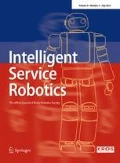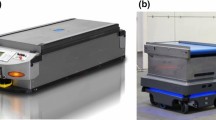Abstract
Everyday robotics are challenged to deal with autonomous product handling in applications such as logistics or retail, possibly causing damage to the items during manipulation. Traditionally, most approaches try to minimize physical interaction with goods. However, this paper proposes to take into account any unintended object motion and to learn damage-minimizing manipulation strategies in a self-supervised way. The presented approach consists of a simulation-based planning method for an optimal manipulation sequence with respect to possible damage. The planned manipulation sequences are generalized to new, unseen scenes in the same application scenario using machine learning. This learned manipulation strategy is continuously refined in a self-supervised, simulation-in-the-loop optimization cycle during load-free times of the system, commonly known as mental simulation. In parallel, the generated manipulation strategies can be deployed in near-real time in an anytime fashion. The approach is validated on an industrial container-unloading scenario and on a retail shelf-replenishment scenario.














Similar content being viewed by others
Notes
The initial training set size should depend on the maximum tolerable time until the classifier is required for the first time.
Convergence of the optimization method strongly depends on the concrete implementation and application scenario and is hard to define generically as explained in the evaluation section.
References
Stoyanov T, Vaskevicius N, Mueller CA, Fromm T, Krug R, Tincani V, Mojtahedzadeh R, Kunaschk S, Mortensen Ernits R, Ricao Canelhas D, Bonilla M, Schwertfeger S, Bonini M, Halfar H, Pathak K, Rohde M, Fantoni G, Bicchi A, Birk A, Lilienthal A, Echelmeyer W (2016) No more heavy lifting: robotic solutions to the container unloading problem. Robot Autom Mag 23(4):94–106
Stilman M, Schamburek JU, Kuffner J, Asfour T (2007) Manipulation planning among movable obstacles. In: International conference on robotics and automation
Katz D, Venkatraman A, Kazemi M, Bagnell JA, Stentz A (2013) Perceiving, learning, and exploiting object affordances for autonomous pile manipulation. In: Robotics: science and systems
Eppner C, Hofer S, Jonschkowski R, Martin-Martin R, Sieverling A, Wall V, Brock O (2016) Lessons from the Amazon picking challenge: Four aspects of building robotic systems. In: Robotics: science and systems
Correll N, Bekris K, Berenson D, Brock O, Causo A, Hauser K, Okada K, Rodriguez A, Romano J, Wurman P (2018) Analysis and observations from the first amazon picking challenge. Trans Autom Sci Eng 15(1):172–188
Pavlichenko D, Martin Garcia G, Koo S, Behnke S (2018) KittingBot: A mobile manipulation robot for collaborative kitting in automotive logistics. In: International conference on intelligent autonomous systems
Kahneman D, Tversky A (1981) The simulation heuristic. Stanford university, Department of psychology, Technical report
Battaglia P, Hamrick J, Tenenbaum J (2013) Simulation as an engine of physical scene understanding. Proc Natl Acad Sci USA 110(45):18,327-32
Kunze L, Beetz M (2017) Envisioning the qualitative effects of robot manipulation actions using simulation-based projections. Artif Intell 247:352–380
Akbari A, Gillani M, Rosell J (2015) Task and motion planning using physics-based reasoning. In: International conference on emerging technologies and factory automation
Weitnauer E, Haschke R, Ritter H (2010) Evaluating a physics engine as an ingredient for physical reasoning. In: International conference on simulation, modeling, and programming for autonomous robots
Hangl S, Ugur E, Szedmak S, Piater J. (2016) Robotic playing for hierarchical complex skill learning. In: International conference on intelligent robots and systems
Bozcuoglu AK, Beetz M (2017) A cloud service for robotic mental simulations. In: International conference on robotics and automation
Haidu A, Beetz M (2016) Action recognition and interpretation from virtual demonstrations. In: International conference on intelligent robots and systems, pp 2833–2838
Levine S, Pastor P, Krizhevsky A, Quillen D (2016) Learning hand-eye coordination for robotic grasping with deep learning and large-scale data collection. In: International symposium on experimental robotics
Fromm T, Birk A (2016) Physics-based damage-aware manipulation strategy planning using scene dynamics anticipation. In: International conference on intelligent robots and systems
Fromm T, Mueller CA, Pfingsthorn M, Birk A, Di Lillo P (2017) Efficient continuous system integration and validation for deep-sea robotics applications. In: Oceans
Winkler J, Balint-Benczedi F, Wiedemeyer T, Beetz M, Vaskevicius N, Mueller CA, Fromm T, Birk A (2016) Knowledge-enabled robotic agents for shelf replenishment in cluttered retail environments. In: International conference on autonomous agents and multiagent systems
Vaskevicius N, Mueller CA, Bonilla M, Tincani V, Stoyanov T, Fantoni G, Pathak K, Lilienthal A, Bicchi A, Birk A (2014) Object recognition and localization for robust grasping with a dexterous gripper in the context of container unloading. In: International conference on automation science and engineering
Mueller CA, Pathak K, Birk A (2014) Object shape categorization in RGBD images using hierarchical graph constellation models based on unsupervisedly learned shape parts described by a set of shape specificity levels. In: International conference on intelligent robots and systems
Vaskevicius N, Pathak K, Ichim A, Birk A (2012) The Jacobs Robotics approach to object recognition and localization in the context of the ICRA’11 solutions in perception challenge. In: International conference on robotics and automation
Koenig N, Howard A (2004) Design and use paradigms for gazebo, an open-source multi-robot simulator. In: International conference on intelligent robots and systems
Sucan I, Moll M, Kavraki L (2012) The open motion planning library. Robot Autom Mag 19(4):72–82
Mojtahedzadeh R, Lilienthal A (2015) A principle of minimum translation search approach for object pose refinement. In: International conference on intelligent robots and systems
Okada K, Haneda A, Nakai H, Inaba M, Inoue H (2004) Environment manipulation planner for humanoid robots using task graph that generates action sequence. In: International conference on intelligent robots and systems
Kitaev N, Mordatch I, Patil S, Abbeel P (2015) Physics-based trajectory optimization for grasping in cluttered environments. In: International conference of robotics and automation
Dogar M, Hsiao K, Ciocarlie M, Srinivasa S (2012) Physics-based grasp planning through clutter. In: Robotics: science and systems
Goldberg K (1990) Stochastic plans for robotic manipulation. Ph.D. thesis
Taeubig H, Baeuml B, Frese U (2011) Real-time swept volume and distance computation for self collision detection. In: International conference on intelligent robots and systems
von Dziegielewski A, Hemmer M, Schoemer E (2015) High precision conservative surface mesh generation for swept volumes. Trans Autom Sci Eng 12(1):764–769
Abdel-Malek K, Yang J, Blackmore D, Joy K (2006) Swept volumes: fundation [sic], perspectives, and applications. Int J Shape Model 12(1):87–127
Mojtahedzadeh R, Bouguerra A, Schaffernicht E, Lilienthal A (2015) Support relation analysis and decision making for safe robotic manipulation tasks. Robot Auton Syst 71:99–117
Rockel S, Konecny S, Stock S, Hertzberg J, Pecora F, Zhang J (2015) Integrating physics-based prediction with semantic plan execution monitoring. In: International conference on intelligent robots and systems
Pastor P, Kalakrishnan M, Chitta S, Theodorou E, Schaal S (2011) Skill learning and task outcome prediction for manipulation. In: International conference on robotics and automation
Panda S, Hafez A, Jawahar C (2013) Learning support order for manipulation in clutter. In: International conference on intelligent robots and systems
Sjöö K, Jensfelt P (2011) Learning spatial relations from functional simulation. In: International conference on intelligent robots and systems
Fischinger D, Weiss A, Vincze M (2015) Learning grasps with topographic features. Int J Robot Res 34(9):1167–1194
Kappler D, Bohg J, Schaal S (2015) Leveraging big data for grasp planning. In: International conference on robotics and automation, pp 4304–4311
Li W, Leonardis A, Fritz M (2017) Visual stability prediction for robotic manipulation. In: International conference on robotics and automation, pp 2606–2613
Mottaghi R, Rastegari M, Gupta A, Farhadi A (2016) What happens if... learning to predict the effect of forces in images. In: European conference on computer vision
de Sa CR, Soares C, Knobbe A, Cortez P (2017) Label ranking forests. Expert Syst 34(1):1–8
Cheng W, Huehn J, Huellermeier E (2009) Decision tree and instance-based learning for label ranking. In: International conference on machine learning
Zhou Y, Liu Y, Gao XZ, Qiu G (2014) A label ranking method based on Gaussian mixture model. Knowl Based Syst 72:108–113
Grbovic M, Djuric N, Vucetic S (2012) Learning from pairwise preference data using Gaussian mixture model. In: Preference learning workshop, European conference on artificial intelligence
Huellermeier E, Fuernkranz J, Cheng W, Brinker K (2008) Label ranking by learning pairwise preferences. Artif Intell 172(16–17):1897–1916
Huellermeier E, Fuernkranz J (2004) Ranking by pairwise comparison: a note on risk minimization. In: International conference on fuzzy systems
Joachims T (2002) Optimizing search engines using clickthrough data. In: Conference on knowledge discovery and data mining
Sutton C, McCallum A (2011) An introduction to conditional random fields. Mach Learn 4(4):267–373
Burges C, Shaked T, Renshaw E, Lazier A, Deeds M, Hamilton N, Hullender G (2005) Learning to rank using gradient descent. In: International conference on machine learning, pp 89–96
Joachims T (2006) Training linear SVMs in linear time. In: Conference on knowledge discovery and data mining
Xing Z, Pei J, Keogh E (2010) A brief survey on sequence classification. ACM SIGKDD Explor Newslett 12(1):40
le Cessie S, van Houwelingen J (1992) Ridge estimators in logistic regression. Appl Stat 41(1):191–201
Regier T, Carlson L (2001) Grounding spatial language in perception: an empirical and computational investigation. J Exp Psychol Gen 130(2):273–298
Kluth T, Burigo M, Knoeferle P (2016) Shifts of attention during spatial language comprehension: a computational investigation. In: International conference on agents and artificial intelligence
Schwarz G (1978) Estimating the dimension of a model. Annal Stat 6(2):461–464
Vaskevicius N, Pathak K, Birk A (2014) Fitting superquadrics in noisy , partial views from a low-cost RGBD sensor for recognition and localization of sacks in autonomous unloading of shipping containers. In: International conference on automation science and engineering
Weisz J, Allen P (2012) Pose error robust grasping from contact wrench space metrics. In: International conference on robotics and automation
Kendall M (1938) A new measure of rank correlation. Biometrika 30(1/2):81–93
Shalev-Shwartz S, Singer Y (2006) Efficient learning of label ranking by soft projections onto polyhedra. J Mach Learn Res 7:1567–1599
Kumar R, Vassilvitskii S (2010) Generalized distances between rankings. In: International conference on world wide web
Merkel D (2014) Docker: lightweight linux containers for consistent development and deployment. Linux J 2014(239):2
Morgan S, Branicky M (2004) Sampling-based planning for discrete spaces. In: International conference on intelligent robots and systems
Reif J (1985) Depth-first search is inherently sequential. Inf Process Lett 20(5):229–234
Peshkin M, Sanderson A (1987) Planning robotic manipulation strategies for sliding objects. In: International conference on robotics and automation, vol 4, pp 696–701
Acknowledgements
The research leading to the presented results has received funding from the European Union’s Seventh Framework program (EU FP7 ICT-2) within the project “Cognitive Robot for Automation of Logistics Processes” (RobLog) under grant agreement No. 270350.
Author information
Authors and Affiliations
Corresponding author
Additional information
Publisher's Note
Springer Nature remains neutral with regard to jurisdictional claims in published maps and institutional affiliations.
Tobias Doernbach was formerly known as Tobias Fromm.
Rights and permissions
About this article
Cite this article
Doernbach, T. Self-supervised damage-avoiding manipulation strategy optimization via mental simulation. Intel Serv Robotics 12, 333–357 (2019). https://doi.org/10.1007/s11370-019-00286-7
Received:
Accepted:
Published:
Issue Date:
DOI: https://doi.org/10.1007/s11370-019-00286-7




